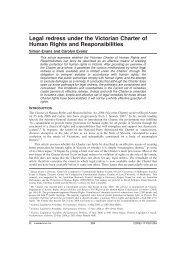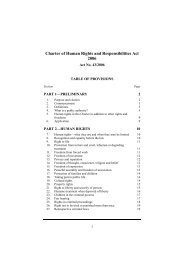The Impact of the Corporate Form on Corporate Liability for ...
The Impact of the Corporate Form on Corporate Liability for ...
The Impact of the Corporate Form on Corporate Liability for ...
You also want an ePaper? Increase the reach of your titles
YUMPU automatically turns print PDFs into web optimized ePapers that Google loves.
142. <str<strong>on</strong>g>The</str<strong>on</strong>g> court also gave weight to CSR’s interest in <str<strong>on</strong>g>the</str<strong>on</strong>g> financial affairs <str<strong>on</strong>g>of</str<strong>on</strong>g> Asbestos Products,<br />
which it c<strong>on</strong>sidered to be ‘over and above that expected in <str<strong>on</strong>g>the</str<strong>on</strong>g> case <str<strong>on</strong>g>of</str<strong>on</strong>g> a holding company’.<br />
For example, <str<strong>on</strong>g>the</str<strong>on</strong>g> approval <str<strong>on</strong>g>of</str<strong>on</strong>g> CSR was required in order to acquire any equipment <str<strong>on</strong>g>of</str<strong>on</strong>g> great<br />
expense. <str<strong>on</strong>g>The</str<strong>on</strong>g>re was also regular reference to Asbestos Products at <str<strong>on</strong>g>the</str<strong>on</strong>g> board meetings <str<strong>on</strong>g>of</str<strong>on</strong>g><br />
CSR <str<strong>on</strong>g>The</str<strong>on</strong>g> court described this as evidence <str<strong>on</strong>g>of</str<strong>on</strong>g> directi<strong>on</strong> c<strong>on</strong>trol or involvement by <str<strong>on</strong>g>the</str<strong>on</strong>g> CSR<br />
board in <str<strong>on</strong>g>the</str<strong>on</strong>g> affairs <str<strong>on</strong>g>of</str<strong>on</strong>g> Asbestos Products (at 484).<br />
143. <str<strong>on</strong>g>The</str<strong>on</strong>g> case highlights <str<strong>on</strong>g>the</str<strong>on</strong>g> ability <str<strong>on</strong>g>of</str<strong>on</strong>g> claimants to avoid <str<strong>on</strong>g>the</str<strong>on</strong>g> approach <str<strong>on</strong>g>of</str<strong>on</strong>g> piercing <str<strong>on</strong>g>the</str<strong>on</strong>g> corporate<br />
veil, by asserting <str<strong>on</strong>g>the</str<strong>on</strong>g> direct negligence <str<strong>on</strong>g>of</str<strong>on</strong>g> <str<strong>on</strong>g>the</str<strong>on</strong>g> parent company. <str<strong>on</strong>g>The</str<strong>on</strong>g>re is no reas<strong>on</strong> why<br />
such principles enunciated in this case could not apply to <str<strong>on</strong>g>the</str<strong>on</strong>g> liability <str<strong>on</strong>g>of</str<strong>on</strong>g> a parent company<br />
<strong>for</strong> <str<strong>on</strong>g>the</str<strong>on</strong>g> activities <str<strong>on</strong>g>of</str<strong>on</strong>g> its subsidiary overseas.<br />
10.2 <str<strong>on</strong>g>The</str<strong>on</strong>g> case <str<strong>on</strong>g>of</str<strong>on</strong>g> James Hardie & Co – asbestos litigati<strong>on</strong> in Australia<br />
144. <str<strong>on</strong>g>The</str<strong>on</strong>g> James Hardie case is an example <str<strong>on</strong>g>of</str<strong>on</strong>g> where <str<strong>on</strong>g>the</str<strong>on</strong>g> Australian Courts have c<strong>on</strong>sidered,<br />
albeit peripherally, <str<strong>on</strong>g>the</str<strong>on</strong>g> questi<strong>on</strong> <str<strong>on</strong>g>of</str<strong>on</strong>g> piercing <str<strong>on</strong>g>the</str<strong>on</strong>g> corporate veil to address <str<strong>on</strong>g>the</str<strong>on</strong>g> tortious liability<br />
<str<strong>on</strong>g>of</str<strong>on</strong>g> parent companies <strong>for</strong> <str<strong>on</strong>g>the</str<strong>on</strong>g> serious harm caused by <str<strong>on</strong>g>the</str<strong>on</strong>g>ir subsidiaries.<br />
145. In Briggs v James Hardie & Co Pty Ltd, Briggs suffered from asbestosis that he alleged<br />
was c<strong>on</strong>tracted whilst employed by a subsidiary <str<strong>on</strong>g>of</str<strong>on</strong>g> James Hardie. James Hardie was,<br />
am<strong>on</strong>g o<str<strong>on</strong>g>the</str<strong>on</strong>g>r things, a producer <str<strong>on</strong>g>of</str<strong>on</strong>g> asbestos products which were proved to c<strong>on</strong>tribute to<br />
meso<str<strong>on</strong>g>the</str<strong>on</strong>g>lioma cancer. Briggs sought an extensi<strong>on</strong> <str<strong>on</strong>g>of</str<strong>on</strong>g> <str<strong>on</strong>g>the</str<strong>on</strong>g> limitati<strong>on</strong> period in which to bring<br />
<str<strong>on</strong>g>the</str<strong>on</strong>g> acti<strong>on</strong>, <strong>on</strong>e requirement <str<strong>on</strong>g>of</str<strong>on</strong>g> which was that <str<strong>on</strong>g>the</str<strong>on</strong>g>re was ‘evidence to establish a cause <str<strong>on</strong>g>of</str<strong>on</strong>g><br />
acti<strong>on</strong>.’ <str<strong>on</strong>g>The</str<strong>on</strong>g> case be<strong>for</strong>e <str<strong>on</strong>g>the</str<strong>on</strong>g> New South Wales Court <str<strong>on</strong>g>of</str<strong>on</strong>g> Appeal <strong>for</strong> an extensi<strong>on</strong> <str<strong>on</strong>g>of</str<strong>on</strong>g> time<br />
require <str<strong>on</strong>g>the</str<strong>on</strong>g> c<strong>on</strong>siderati<strong>on</strong> <str<strong>on</strong>g>of</str<strong>on</strong>g> whe<str<strong>on</strong>g>the</str<strong>on</strong>g>r <str<strong>on</strong>g>the</str<strong>on</strong>g>re was evidence to establish <str<strong>on</strong>g>the</str<strong>on</strong>g> cause <str<strong>on</strong>g>of</str<strong>on</strong>g> acti<strong>on</strong><br />
against <str<strong>on</strong>g>the</str<strong>on</strong>g> parent company.<br />
146. <str<strong>on</strong>g>The</str<strong>on</strong>g> plaintiff argued that <str<strong>on</strong>g>the</str<strong>on</strong>g> corporate veil should be lifted and <str<strong>on</strong>g>the</str<strong>on</strong>g> acti<strong>on</strong>s <str<strong>on</strong>g>of</str<strong>on</strong>g> <str<strong>on</strong>g>the</str<strong>on</strong>g> subsidiary<br />
treated as <str<strong>on</strong>g>the</str<strong>on</strong>g> acti<strong>on</strong>s <str<strong>on</strong>g>of</str<strong>on</strong>g> <str<strong>on</strong>g>the</str<strong>on</strong>g> parent company. <str<strong>on</strong>g>The</str<strong>on</strong>g> court stated that Briggs had to establish<br />
that <str<strong>on</strong>g>the</str<strong>on</strong>g>re was a possibility that evidence existed as against <str<strong>on</strong>g>the</str<strong>on</strong>g> parent company – and in<br />
those circumstances it was relevant whe<str<strong>on</strong>g>the</str<strong>on</strong>g>r <str<strong>on</strong>g>the</str<strong>on</strong>g> acti<strong>on</strong>s <str<strong>on</strong>g>of</str<strong>on</strong>g> <str<strong>on</strong>g>the</str<strong>on</strong>g> subsidiary are treated as<br />
acti<strong>on</strong>s <str<strong>on</strong>g>of</str<strong>on</strong>g> <str<strong>on</strong>g>the</str<strong>on</strong>g> parent. In those circumstances, <strong>on</strong>e <str<strong>on</strong>g>of</str<strong>on</strong>g> <str<strong>on</strong>g>the</str<strong>on</strong>g> Appeal judges, Rogers AJA,<br />
c<strong>on</strong>sidered <str<strong>on</strong>g>the</str<strong>on</strong>g> test to be applied in piercing <str<strong>on</strong>g>the</str<strong>on</strong>g> corporate veil in group situati<strong>on</strong>s.<br />
147. Rogers AJA c<strong>on</strong>sidered <str<strong>on</strong>g>the</str<strong>on</strong>g> authorities in Australia and <str<strong>on</strong>g>the</str<strong>on</strong>g> UK and c<strong>on</strong>cluded that even<br />
<str<strong>on</strong>g>the</str<strong>on</strong>g> commercial reality <str<strong>on</strong>g>of</str<strong>on</strong>g> a parent company's complete c<strong>on</strong>trol over a subsidiary may not<br />
be adequate to persuade a court to pierce <str<strong>on</strong>g>the</str<strong>on</strong>g> corporate veil (at 577), :<br />
… as <str<strong>on</strong>g>the</str<strong>on</strong>g> law presently stands, in my view <str<strong>on</strong>g>the</str<strong>on</strong>g> propositi<strong>on</strong> advanced by <str<strong>on</strong>g>the</str<strong>on</strong>g> plaintiff that <str<strong>on</strong>g>the</str<strong>on</strong>g><br />
corporate veil may be pierced where <strong>on</strong>e company exercises complete domini<strong>on</strong> and c<strong>on</strong>trol<br />
over ano<str<strong>on</strong>g>the</str<strong>on</strong>g>r is entirely too simplistic. <str<strong>on</strong>g>The</str<strong>on</strong>g> law pays scant regard to <str<strong>on</strong>g>the</str<strong>on</strong>g> commercial reality<br />
that every holding company has <str<strong>on</strong>g>the</str<strong>on</strong>g> potential, and more <str<strong>on</strong>g>of</str<strong>on</strong>g>ten than not, in fact does,<br />
exercise complete c<strong>on</strong>trol over a subsidiary..<br />
148. Importantly, however, Rogers AJA did state that different c<strong>on</strong>siderati<strong>on</strong>s should apply in<br />
lifting <str<strong>on</strong>g>the</str<strong>on</strong>g> corporate veil in torts cases as compared with c<strong>on</strong>tract or revenue cases. <str<strong>on</strong>g>The</str<strong>on</strong>g><br />
rati<strong>on</strong>ale <strong>for</strong> this approach was that <str<strong>on</strong>g>the</str<strong>on</strong>g> tort victim has no choice in <str<strong>on</strong>g>the</str<strong>on</strong>g> selecti<strong>on</strong> <str<strong>on</strong>g>of</str<strong>on</strong>g><br />
tortfeasor, whereas in c<strong>on</strong>tract or revenue cases, <str<strong>on</strong>g>the</str<strong>on</strong>g> c<strong>on</strong>tracting party may choose not to<br />
enter into a c<strong>on</strong>tract and o<str<strong>on</strong>g>the</str<strong>on</strong>g>rwise guard against a possibility that a subsidiary will not be<br />
able to pay a debt. A tort victim cannot c<strong>on</strong>trol who will do him or her harm (at 578-9).<br />
9.2.2007 Page 27


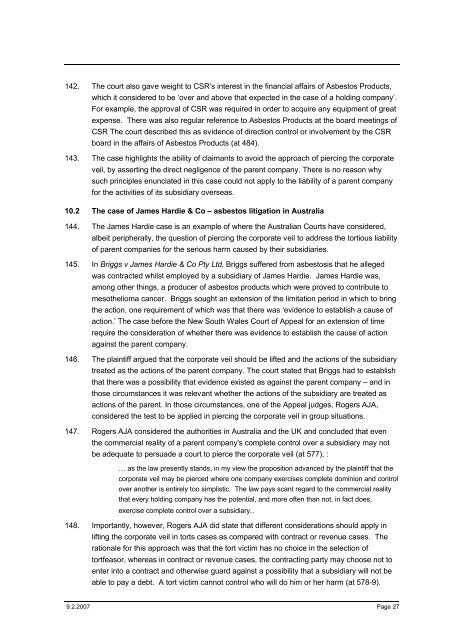
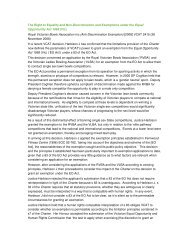
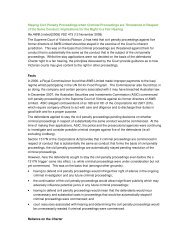
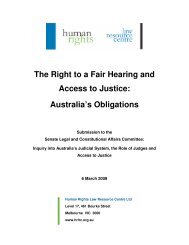
![Maslov v Austria [2008] ECHR - Human Rights Law Centre](https://img.yumpu.com/38882316/1/190x245/maslov-v-austria-2008-echr-human-rights-law-centre.jpg?quality=85)
![Kortel v Mirik [2008].pdf - Human Rights Law Centre](https://img.yumpu.com/38882257/1/190x245/kortel-v-mirik-2008pdf-human-rights-law-centre.jpg?quality=85)

